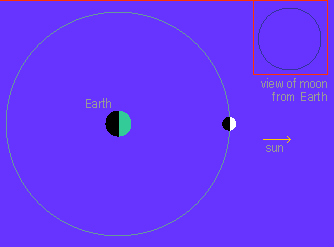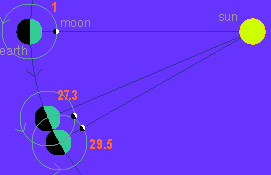 That's right—this scenario could never happen.
That's right—this scenario could never happen.
If the moon is rising while the sun is setting, it has to be on the side of the Earth opposite the sun, and if it's in this position, it has to be full. Similarly, if the moon rises about halfway through the night, it will be half-lit, or in its first quarter phase. And if it rises close to dawn, it will be a new moon.
 The time it takes the moon to go through its phases is 29.5 days.
But that's not how long it takes the moon to orbit the Earth...well,
it is and it isn't. It really takes the moon only 27.3 days to orbit
the Earth. But during that time the Earth moves along its orbit
around the sun quite a bit. So for the moon to move to the same
point relative to the Earth and the sun, it has to catch up and thus
takes a little longer. That's why, from our perspective (and that's
the one that really matters), it takes 29.5 days for a full moon to
move through its phases and return to being full.
The time it takes the moon to go through its phases is 29.5 days.
But that's not how long it takes the moon to orbit the Earth...well,
it is and it isn't. It really takes the moon only 27.3 days to orbit
the Earth. But during that time the Earth moves along its orbit
around the sun quite a bit. So for the moon to move to the same
point relative to the Earth and the sun, it has to catch up and thus
takes a little longer. That's why, from our perspective (and that's
the one that really matters), it takes 29.5 days for a full moon to
move through its phases and return to being full.
The next lunar puzzler...
Explore the Moon | Lunar Puzzlers | Last Man on the Moon
Hear the Space Pioneers | Origins | Resources
Transcript | Site Map | To the Moon Home
Editor's Picks | Previous Sites | Join Us/E-mail | TV/Web Schedule
About NOVA | Teachers | Site Map | Shop | Jobs | Search | To print
PBS Online | NOVA Online | WGBH
© | Updated November 2000